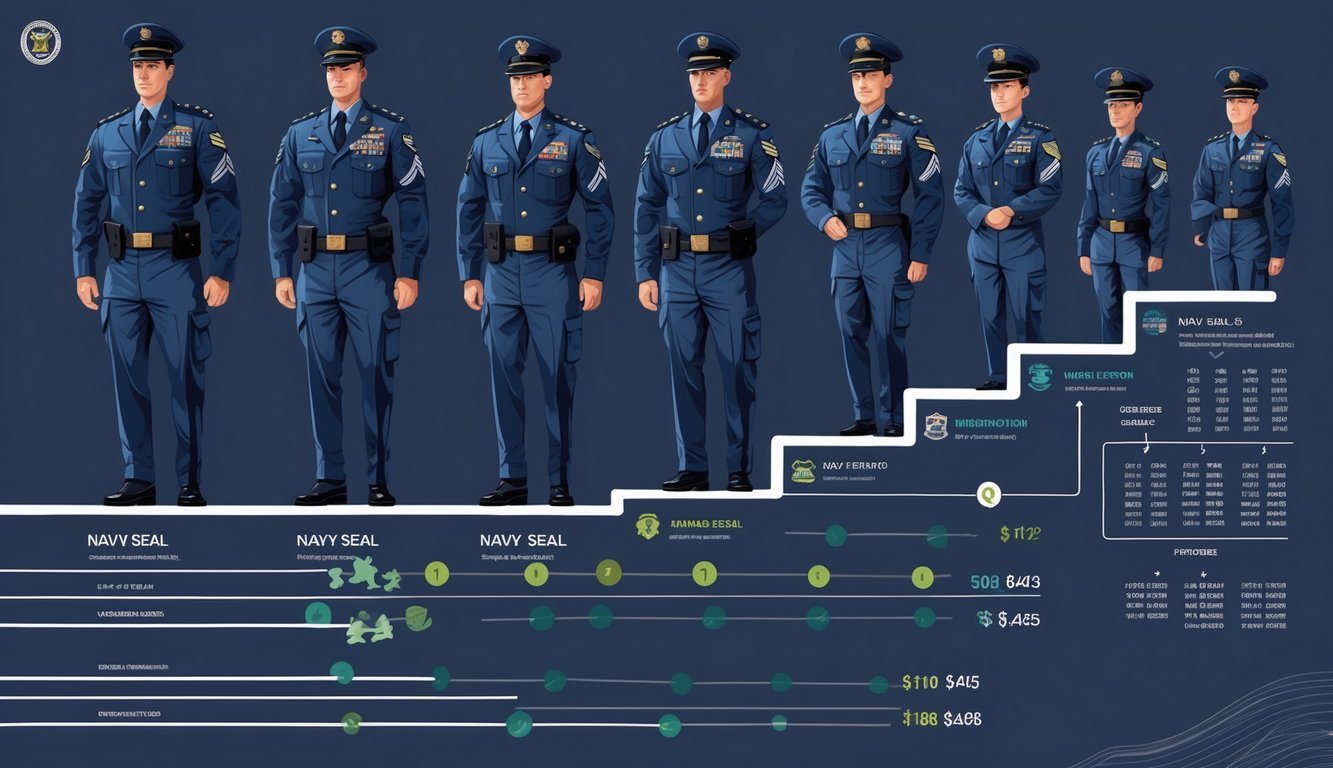PsychNewsDaily Publishers
100 Summit Drive
Burlington, MA, 01803
Telephone: (320) 349-2484
PsychNewsDaily Publishers
100 Summit Drive
Burlington, MA, 01803
Telephone: (320) 349-2484
Navy SEALs earn an average salary of $90,000 to $98,000 annually, influenced by rank, experience, bonuses, and various allowances for housing and food.

Navy SEALs are among the most elite members of the U.S. military. You might wonder what kind of pay they actually bring home, considering the danger and demands.
In 2025, the average Navy SEAL salary lands somewhere between $90,000 and $98,000 each year, though that number shifts depending on rank, experience, and all kinds of extra incentives.
Pay for Navy SEALs isn’t some flat, simple number on a check. The total comes from base pay, special duty pay, and bonuses tied to their skills and the tough work they do.
If you want to see how their pay stacks up against the risks and the training, you’re in the right place. This guide lays out the numbers and facts you actually care about.

When you become a Navy SEAL, your pay comes from several sources that add up in interesting ways. Your base salary changes depending on your rank and how long you’ve served.
You also get extra money for housing, food, and certain duties. Bonuses for specific skills or reenlisting can boost your total pay. Stuff like where you live and your family situation also play a part in your final earnings.
Your base pay depends on your rank and your years of service. New SEALs start out making less than those who’ve been around for a while.
The Navy sets base pay with official pay scales, and you’ll see a bump with every year you stick around.
Here’s a quick breakdown of what base pay looks like in the early years:
| Years of Service | Approximate Monthly Base Pay |
|---|---|
| 0-2 years | $2,000 – $2,500 |
| 3-5 years | $2,500 – $3,000 |
| 6+ years | $3,000+ |
Your monthly pay is just the starting point. This is before any allowances or extra pay.
On top of base pay, you get allowances for housing and food. The Basic Allowance for Housing (BAH) helps if you don’t live in Navy housing. The amount changes depending on where you’re stationed and if you have dependents.
You’ll also get the Basic Allowance for Subsistence (BAS) to help with food costs. That’s pretty much the same for everyone in the service.
You might receive family separation allowance if you’re away from your family, plus medical benefits and life insurance. These benefits help support you and your family while you serve.
The Navy offers different bonuses to reward your skills and commitment. When you join as a SEAL, you could get an enlistment bonus, though the amount varies depending on how much the Navy needs you.
You might also earn reenlistment bonuses if you decide to stay in longer. These can be pretty big, especially if you have tough-to-find skills like diving or parachuting.
You’ll get special pays like hazardous duty pay and dive pay, too. These add more to your paycheck because of the extra risks you take on the job.
A bunch of factors tweak your take-home pay. Your rank, years of service, and your specific job specialty all matter.
Where you’re stationed affects your housing allowance, and if you’re married or have kids, those allowances go up.
Other things like performance raises, special duty assignments, and eligibility for critical skills bonuses can change your total pay. So, your real earnings are usually higher than just your base salary.
All these pieces—base pay, allowances, bonuses, and differences based on location—make up the real Navy SEAL salary.

Your Navy SEAL career means moving up through different ranks and roles as you get more experience and tackle new training. Every step brings more responsibility and, yeah, higher pay.
You might start out enlisted or go the officer route, with opportunities to specialize and earn retirement benefits down the line.
Most people start as enlisted sailors, beginning at E-1 (Seaman Recruit). After you finish BUD/S training, you can move up to Petty Officer, Chief Petty Officer, Master Chief Petty Officer, or even Command Master Chief Petty Officer.
Promotion comes from time in service, strong performance, and passing certain exams. For instance, moving from Petty Officer Third Class to Chief Petty Officer takes leadership chops and technical know-how.
Master Chief Petty Officer is one of the top enlisted ranks, and it comes with serious respect—and a bigger paycheck.
Your Navy rank drives your monthly pay, and higher ranks mean more bonuses and special pay as a SEAL. As you move up, you might train new SEALs or lead teams during missions.
If you go the officer route, you’ll start as an Ensign (O-1) after commissioning. Then you can move up to Lieutenant Junior Grade, Lieutenant, Lieutenant Commander, Commander, and Captain.
The highest ranks—Rear Admiral, Vice Admiral, and Admiral—are pretty rare for SEAL officers, but they’re out there.
Officers lead larger groups and handle strategy, planning, and resources. Many officer SEALs balance field leadership with administrative work.
To become an officer SEAL, you’ll need to finish BUD/S and take extra leadership courses.
Officer careers offer higher pay and more chances to direct missions. You might also work with other military branches.
You can pick up special job titles called MOS (Military Occupational Specialty) within Naval Special Warfare. Examples are sniper, diver, medic, or communications specialist.
These skills make you more valuable and can bump up your pay.
Special roles need extra training beyond BUD/S. You might end up as a team leader, sniper instructor, or tactical planner.
The Navy gives titles like Command Master Chief Petty Officer or Master Chief Petty Officer of the Navy to the most experienced SEALs.
These jobs let you focus on what you’re best at and help new members get up to speed.
You can retire from the Navy after 20 years, which happens for a lot of SEALs in their 40s. Retirement pay depends on your rank and how long you served.
Higher ranks like Master Chief Petty Officer or Commander get better pensions.
A lot of SEAL veterans also qualify for benefits like healthcare and education through the VA. Long-term compensation includes retirement pay, disability benefits if you qualify, and special bonuses during your service.
SEAL retirement plans reward you for sticking with the Navy and Naval Special Warfare. You might keep working in civilian roles or related fields after you leave the military.

When you first start out as a Navy SEAL, your pay matches the entry-level enlisted rate, but it goes up as you climb the ranks and gain experience.
You’ll also get special pay and benefits for your skills and assignments.
If you’re just starting as a Navy SEAL at the lowest rank, you’ll make about $1,500 a month. That lines up with the usual starting pay for an E-1 in the Navy.
As you move up, your pay rises steadily. E-4 ranks pull in over $4,000 a month, and higher ranks earn even more based on the Navy’s pay tables.
You can snag extra pay like hazardous duty pay, sea pay, or bonuses for finishing certain training. These perks add extra income on top of your regular salary.
Team 6 members usually get extra special pay because of the risk and secrecy involved. So, if you’re on that unit, your total pay could be higher.
A Master Chief, which is way up there for enlisted ranks, can earn anywhere from $6,500 to $8,000 or more each month, depending on years served.
Yeah, you can actually earn extra pay if you pick up specialist skills—think sniper or demolition expert. These bonuses can bump up your total earnings past the standard SEAL salary.